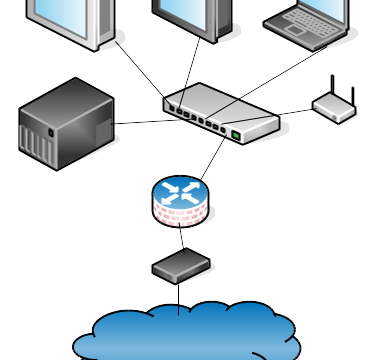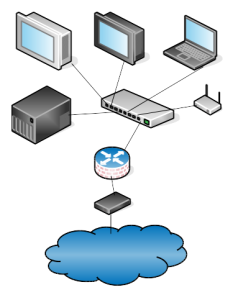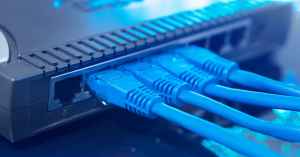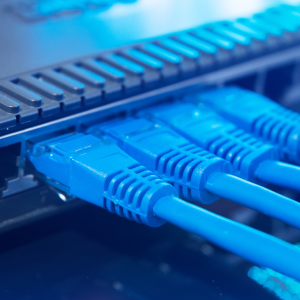
In the digital age, the backbone of any computer network is its hardware. Network hardware comprises various devices and equipment essential for the establishment, operation, and maintenance of a computer network. In this article, we will delve into what network hardware is, the types of network hardware equipment available, and their roles in computer networks.
What is Network Hardware?

Network hardware refers to the physical devices required for communication and interaction between devices on a computer network. These devices are responsible for data transmission, connectivity, and overall network functionality. Network hardware can be as simple as a network cable or as complex as a router or switch.
Types of Network Hardware Equipment
Network hardware equipment varies widely, each serving a unique purpose to ensure efficient and secure data transfer. Here are some of the most common types:
- Routers: Routers are devices that connect multiple networks together and direct data packets between them. They are essential for directing traffic on the internet, ensuring that data sent from one network reaches the correct destination on another network.
- Switches: Switches are used within a network to connect devices and manage data traffic. Unlike hubs, switches are more intelligent; they can inspect data packets and direct them to the appropriate device rather than broadcasting to all connected devices.
- Hubs: Hubs are basic devices that connect multiple Ethernet devices, making them act as a single network segment. They are simpler than switches as they broadcast data to all ports, which can lead to network inefficiencies.
- Modems: Modems are devices that modulate and demodulate signals for data transmission over telephone lines or cable systems. They are crucial for converting digital data from computers into analog signals for transmission over these systems and vice versa.
- Network Interface Cards (NICs): NICs are hardware components that allow computers to connect to a network. They can be installed internally in the device or connected externally via USB ports.
- Access Points: Access points (APs) are devices that create a wireless local area network (WLAN), enabling wireless devices to connect to a wired network. They are commonly used in homes and businesses to extend the range of a wireless network.
- Firewalls: Firewalls are security devices that monitor and control incoming and outgoing network traffic based on predetermined security rules. They are essential for protecting networks from unauthorized access and cyber threats.
- Cables and Connectors: Network cables and connectors are the physical mediums through which data is transmitted. Common types include Ethernet cables (e.g., Cat5, Cat6) and fiber optic cables.
Network Hardware in Computer Networks

The role of network hardware in computer networks is critical. Each type of hardware has a specific function that contributes to the overall performance, security, and reliability of the network. Let’s explore how these devices interact within a network:
Data Transmission
Network hardware ensures that data is transmitted efficiently between devices. Routers and switches play a significant role in directing data packets, reducing congestion, and maintaining high-speed communication. Modems and NICs facilitate the initial connection to the network, allowing devices to send and receive data.
Connectivity
Without network hardware, devices would not be able to connect and communicate with each other. Hubs, switches, and access points enable multiple devices to join the network, whether through wired or wireless connections. This connectivity is crucial for the functionality of local area networks (LANs) and wide area networks (WANs).
Security
Network hardware also contributes to the security of computer networks. Firewalls act as the first line of defense, blocking unauthorized access and protecting sensitive data. Routers often include built-in security features such as VPN support and encryption, adding another layer of protection.
Network Management
Managing a computer network involves monitoring and configuring hardware to ensure optimal performance. Network hardware such as switches and routers come with management interfaces that allow network administrators to configure settings, monitor traffic, and troubleshoot issues. This management capability is essential for maintaining a stable and efficient network.
Importance of Network Hardware’

Understanding the importance of network hardware in computer networks is crucial for anyone involved in network design, implementation, or management. Here are some key reasons why network hardware is vital:
- Reliability: High-quality network hardware ensures reliable communication between devices. This reliability is essential for businesses that depend on continuous network availability for their operations.
- Performance: Efficient network hardware can significantly improve the performance of a network. High-speed routers, switches, and cables reduce latency and increase data transfer speeds, enhancing the user experience.
- Scalability: As networks grow, scalable hardware solutions allow for easy expansion. Modular switches and routers, for example, can accommodate additional ports or modules to support more devices and higher traffic volumes.
- Security: Network hardware with advanced security features helps protect against cyber threats. Firewalls, secure routers, and encrypted connections safeguard sensitive information and maintain the integrity of the network.
- Cost-Effectiveness: Investing in robust network hardware can be cost-effective in the long run. Quality devices reduce the need for frequent replacements and minimize downtime caused by hardware failures.
Future Trends in Network Hardware
As technology evolves, so does network hadware. Emerging trends in network hrdware include:
- 5G Technology: The rollout of 5G networks is revolutionizing wireless communication, offering higher speeds and lower latency. Network harware such as 5G routers and modems are becoming increasingly important for leveraging this technology.
- Internet of Things (IoT): The proliferation of IoT devices requires specialized network ardware to handle the increased connectivity demands. IoT gateways and sensors are examples of hardware designed to support this growing trend.
- Software-Defined Networking (SDN): SDN technology separates the control plane from the data plane in network devices, allowing for more flexible and efficient network management. SDN-compatible hardware is becoming more prevalent in modern networks.
- Cloud Networking: As more services migrate to the cloud, network hrdware that supports seamless cloud integration is essential. Cloud-managed switches and access points enable efficient management of network resources across distributed environments.
Conclusion
Network hardware is the foundation of any computer network, enabling communication, connectivity, and security. Understanding the various types of network hardware and their roles in computer networks is essential for designing, implementing, and managing efficient and secure networks. As technology continues to advance, staying informed about the latest trends in network hardware will ensure that your network remains robust, scalable, and capable of meeting future demands.
If you have any questions for us, you can see more at: https://hardwarepc.xyz/, X




